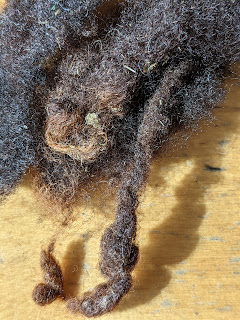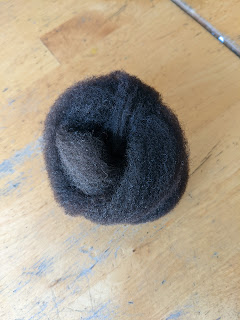Fiber Monday - Combing wool
Before I get to fiber-y stuff, I wanted to thank everyone for their kind and supportive comments regarding yesterday's post. I truly appreciate each and every one of them. And would you believe? I only lost one Facebook "friend". I was truly expecting a higher number, but I'll admit there has been some thinning that has happened over the past two years. Anyway, thank you.
I spent some time combing some of the fleece that I am working on processing today. Yesterday I rewashed about 0.6 ounces and I had some time today so I set myself up in the dining room in the sun and got it all combed. Because I am pretty sure that among the hundred of people who read this blog every day that I am the only person who spins because if there are any spinners out there reading I'm sure they would have said something by now. So I thought every now and then I would spend some time sharing what various parts of the process to go from fleece to spinnable fiber look like. (Plus, some of this is just me documenting what I've done so I have it recorded somewhere.)
Here is what I am starting with. These are cleaned locks from a CVM fleece. Sheep's wool naturally grows in locks and many people pull these apart to work with. These locks don't look like much at the moment. The have bleached tips and a lot of vegetable matter (VM) in them.
Here is a closer view.
Step one is to load the wool comb with some of the locks. I love that my combs came with a stand so I can mount one of the combs on the table. It just makes the whole process easier.
Then, the second comb, which is held in the hand, is used to slowly sweep the locks off the stationary comb onto the handheld comb. You catch the outside edge going first one direction and then the other. Eventually all of the wool is transferred from one comb to the other.
Here is the waste that is left on the stationary comb after the first pass is finished.
And here is the wool on the handheld comb. You can see the locks are quite a bit more open now.
The next step is to transfer the wool from the handheld comb back to the stationary comb. Holding the comb as in the picture, the handheld comb moves up and down, this time catching the outside edge of the wool onto the tines of the stationary comb.
With each pass of the comb, the locks are opened up and straightened, while the VM and the short bits either drop out or are caught behind the tines. After doing this pair of actions two or three times (depending on how much combing the wool needs), you end up with clean and organized wool. Now comes the part I like the best.
This is a diz. It came with my wool combs so it is a particularly nice one, but really anything with a small hole in it can serve as a diz. They are used to pull combed wool off a comb or a hackle.
Here I have just started feeding the combed wool through the diz. As I gently pull it a sort of rope comes through the diz and eventually all the combed wool will come off the comb.
Here it is a little farther along.
And this is what you end up with. This amount of wool is probably less than 1/10 of an ounce.
To store the wool, I wind it up like this into a little bird's nest shape.
While a lot of the VM comes out during the combing, there is always some that comes out during the spinning process as evidenced by what my pant leg looked like when I was finished this afternoon. I don't know if you can see all the little bits of grass type bits there. (Ignore the white hairs. Those are from Emmy. I don't know why I wear black pants to the barn to groom a grey horse who is shedding like crazy, but I do.)
So some other details, which are mainly for me to remember. I am spinning this wool at about 36 wraps per inch making the singles a lace weight yarn. At this size, I will need to spin about 3 ounces of each single to get the amount of yarn I need for a 3-ply sock weight yarn.
Here's what about an ounce of spun wool looks like on the bobbin.
I was forward thinking this time and actually planned what I needed to spin. I took some of the commercial yarn from my last pair of socks that I took apart. I liked the weight of the yarn and wanted to try to reproduce it. A single from that 4-ply is about 46 wraps per inch, making it a little smaller than what I am spinning which is exactly what I want since I am making a 3-ply yarn. (Don't you love this little card? It's handy to have while I spin because I can periodically check that I'm on track.)
But I do think I have a fleece problem. Having sorted out my issued with the first one, I am feeling more confident I can actually successfully process fleece. It also happens to be later winter/early spring when sheep are sheared. There are a lot of raw fleeces for sale on the internet right now. I told you about the 9 pound fleece which arrived a couple of weeks ago. I had a second fleece arrive this past week. This is from a Babydoll sheep (which, when we get sheep is one of the breeds at the top of my list). It is only 3.3 pounds. It is also pretty dirty and will probably need a lot of washing.
All together I now have 9+ pounds of unprocessed wool sitting in my studio.
I haven't totally lost my mind, though. I figure this will keep me in fiber for the next year at a fraction of the cost. If you buy prepared and dyed combed wool top it will run you anywhere between $28 to $35 for four ounces. I tend to like to spin more than one skein of anything so typically I would buy 8 ounces. Well, I did the math, and even assuming that half of the weight of the fleeces I bought ends up being waste, that would still give me approximately six pounds of spinnable fiber to play with at the bargain price of ~$3.40/four ounces. Plus, the two fleeces in those boxes are white which means they will be perfect to try different dyes with this summer.
I have cut myself off from buying more fleeces even though every couple of days I see one that I would love to play with. Over nine pounds of wool is probably sufficient.
And if you have made it this far, I have one little fiber annoyance to share with you. This morning, everyone was watching the Nova series where they have scientists try to recreate ancient monuments. I think it's called Secrets of Lost Civilizations and my children have all loved watching them over the years. Today they were watching one about trying to figure out how the awning on the Colosseum was constructed. I kept hearing these scientist/historian types talking about the canvas that they were putting up. I eventually asked if at anytime they mentioned where this canvas would have come from or even what it was made out of. My children said no, there was never any mention of it. It really did seem as though they thought that the original builders of the Colosseum just popped down to Fabrics R Us and purchased the canvas that was needed. Right. Romans did have access to cotton as well as flax (for linen) and wool. Every single inch of it would have been spun on spindles and then woven by hand. I'm pretty sure they didn't have anything resembling modern canvas. So, all of these scientists and historians were trying to construct something based on a fabric that didn't exist and was probably significantly heavier than what was originally used. Once again, cloth and yarn are totally overlooked as if they are something that just appears without any effort behind them.





















Comments